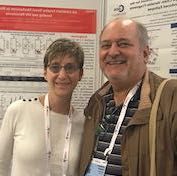Article
Tofacitinib, Ruxolitinib Work To Prevent HIV Transmission Between Cells, Reduce Seeding of HIV Reservoir
Author(s):
Jak inhibitors could represent an add-on therapy to existing antiretrovirals, addressing an unmet clinical need for HIV-infected individuals.
Christina Gavegnano, PhD, assistant professor, Emory University, Raymond Schinazi, PhD, DSc, Frances Winship Walters Professor of Pediatrics, Director, Laboratory of Biochemical Pharmacology, Director, HIV-Cure Scientific Working Group, Emory University Center for AIDS Research

Christina Gavegnano, PhD (Left) and Raymond Schinazi, PhD, DSc (Right)
Tofacitinib and ruxolitinib appear to “block” viral production of HIV-infected human cells as well as prevent viral transmission and inhibit seeding of the HIV reservoir, according to a study published in PLOS Pathogens.1
“The study demonstrates for the first time that selective blockade of HIV-driven inflammation with a Jak inhibitor can reduce the size of the HIV reservoir,” added study investigator Christina Gavegnano, PhD, assistant professor, Emory University. “To date, no existing antiviral agents can decay the viral reservoir, which is why a cure has not been achieved.”
A total of 37 patients with HIV controlled by antiretroviral drugs were included in this study. Investigators evaluated the association between HIV persistence and the Jak-STAT pathway and assessed whether 2 Jak inhibitors — tofacitinib and ruxolitinib — were able to “block” both the seeding as well as maintenance of the in vitro HIV reservoir.
Both tofacitinib and ruxolitinib are FDA-approved Jak inhibitors for use in patients with polycythemia vera, rheumatoid arthritis, or myelofibrosis.
In in vivo and in vitro, phosphorylation of STAT5 demonstrated a strong correlation with high integrated viral DNA levels. Additionally, the administering of in vitro Jak inhibitors resulted in a reduced rate of the integrated HIV DNA “harbored” by CD4+ T cells.
The results from this study demonstrated that Jak inhibitors effectively block HIV-infected cells’ viral production as well as inhibit and block γ-C receptor cytokine (IL-15)-induced viral reactivation.
Effectively, these findings show that Jak inhibitors may ultimately prevent the transmission of HIV to bystander T cells, resulting in potentially reduced progression of the disease.
According to the investigators, Jak inhibitors “target key events downstream of γ-C cytokine (IL-2, IL-7 and IL-15) ligation to their receptors, impacting the magnitude of the HIV reservoir in all memory CD4 T cell subsets in vitro and ex vivo.”
The Jak inhibitors resulted in a significant reduction in IFN-α induced STAT1 phosphorylation in CD14+ monocytes and CD4+ T-cells, as well as decreased IFN-α stimulated STAT5 phosphorylation in CD4+ T-cells. Based on these findings, the investigators believe these 2 therapies may play a role in lower hyperimmune activation in the HIV+ patient.
Utilizing a Jak inhibitor, researchers are able to “block” specific inflammatory cytokines within an HIV cell, essentially preventing viral replication by facilitating a challenging environment conducive for the prevention of cell activation.
“Adding a Jak inhibitor to existing antiretroviral regimens for HIV treatment has the potential to decay the viral reservoir to the point that antiretrovirals could be withdrawn without virus rebound,” Dr. Gavegnano, told MD Magazine. “Additionally, HIV-induced inflammation in the brain is poorly addressed by existing antiretrovirals and confers mild HIV Associated Neurocognitive Impairments (HAND) in up to 50% of persons living with HIV, even with a well-controlled virus.”
In addition, Dr. Gavegnano believes Jak inhibitors could be helpful therapeutic options for reversing or preventing HAND among individuals with HIV, a condition that is not currently addressed by today’s antiretroviral agents.
According to Dr. Gavegnano, “It is possible that Jak inhibitors could represent an add-on therapy to existing antiretrovirals that could address the unmet clinical need of reducing chronic inflammation that persists in people living with HIV.”
REFERENCE
- Gavegnano C, Brehm JH, Dupuy FP, et al. Novel mechanisms to inhibit HIV reservoir seeding using Jak inhibitors. PLoS Pathog. 2017;13(12):e1006740.
Related Coverage >>>
Lyndra Announces Feasibility Study of Oral Once-Weekly HIV Drug
Virus Seems Able to Destroy Latent HIV-Infected Cells
Preclinical Study Suggests Modified T-cells May Fight HIV





